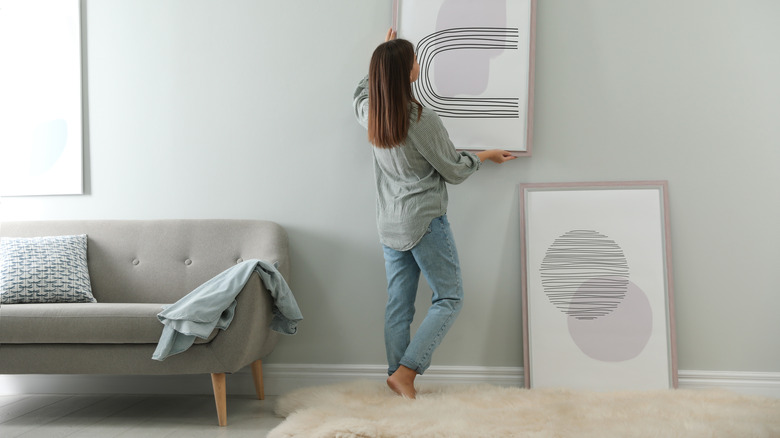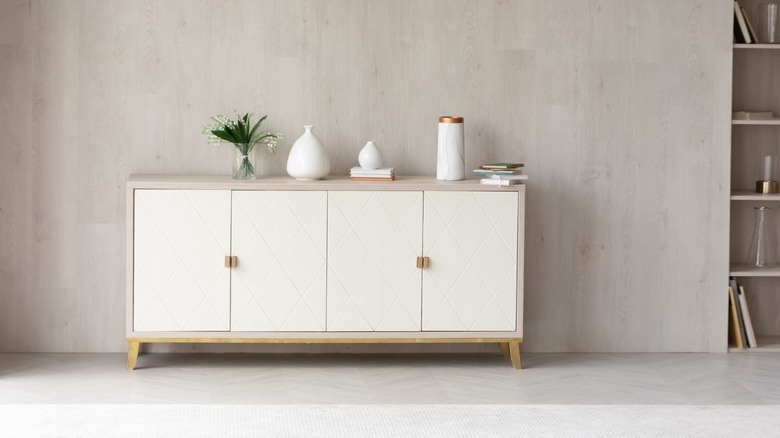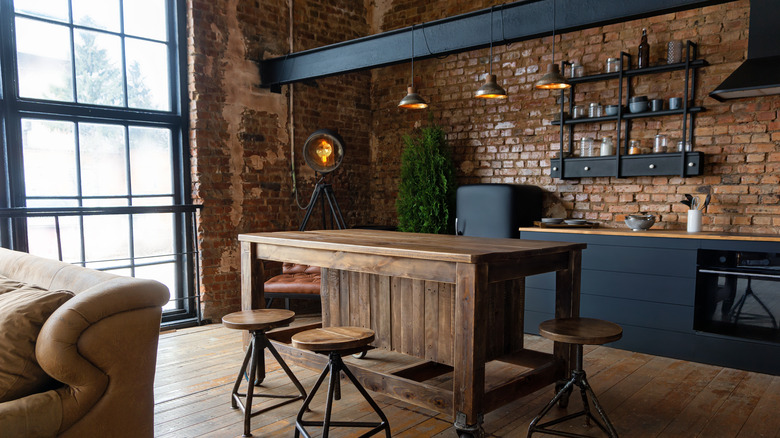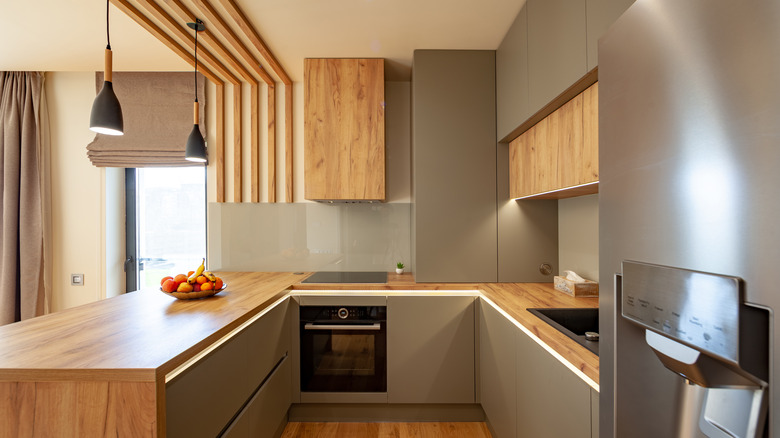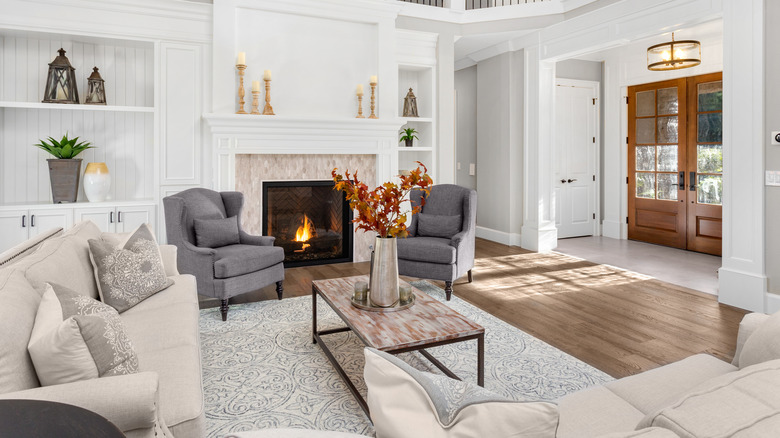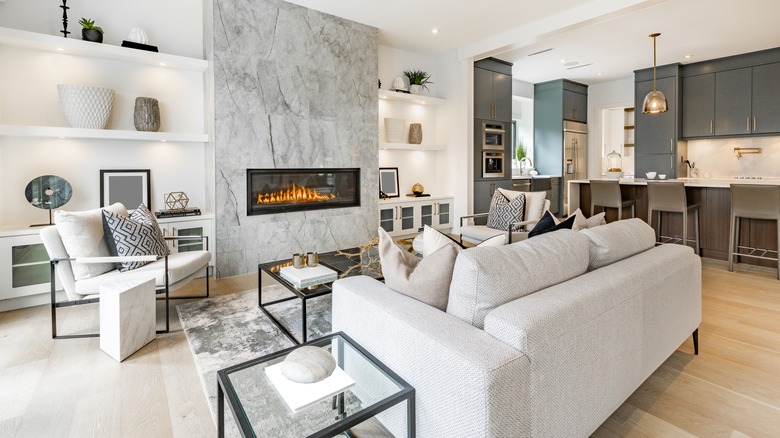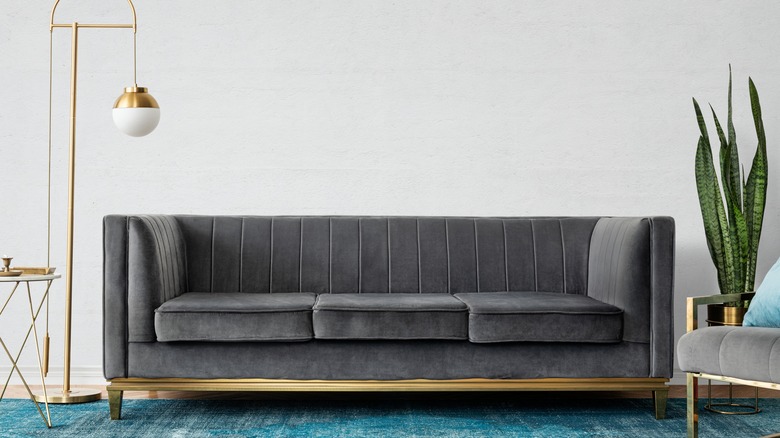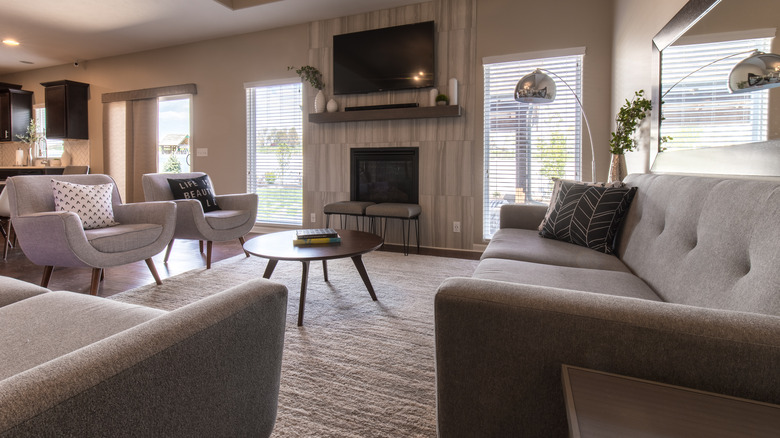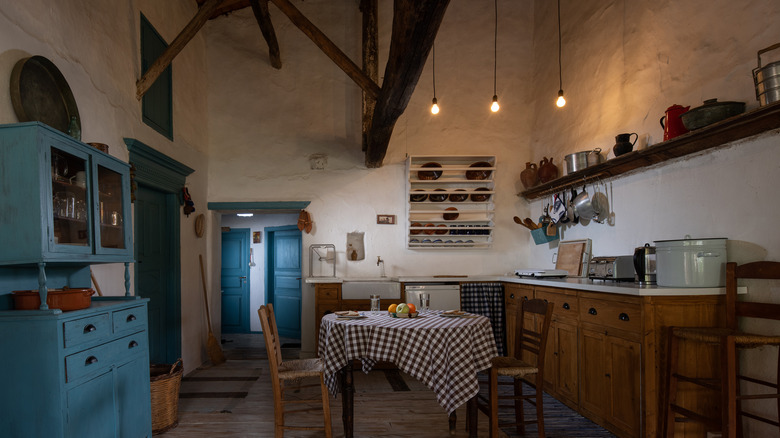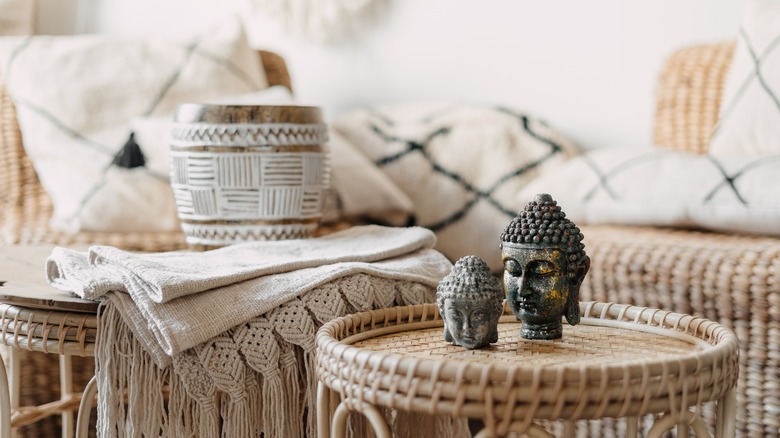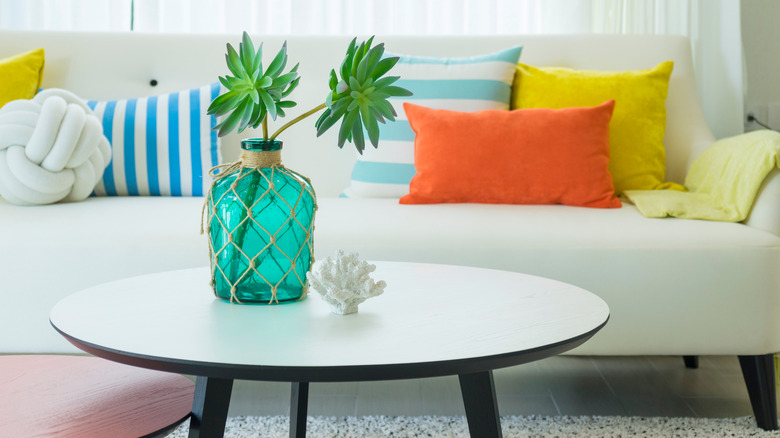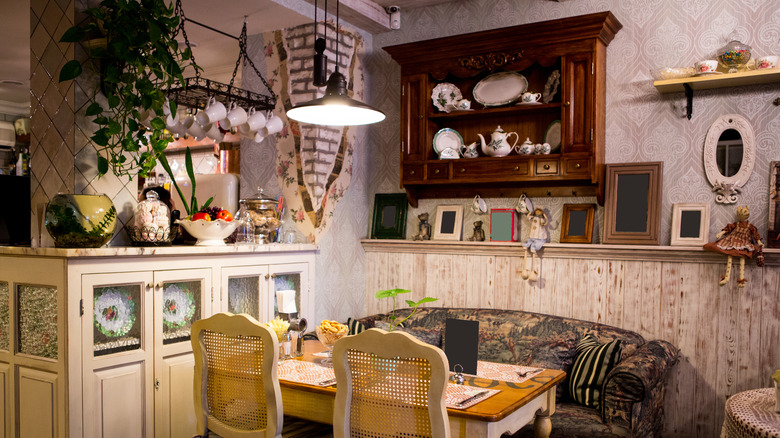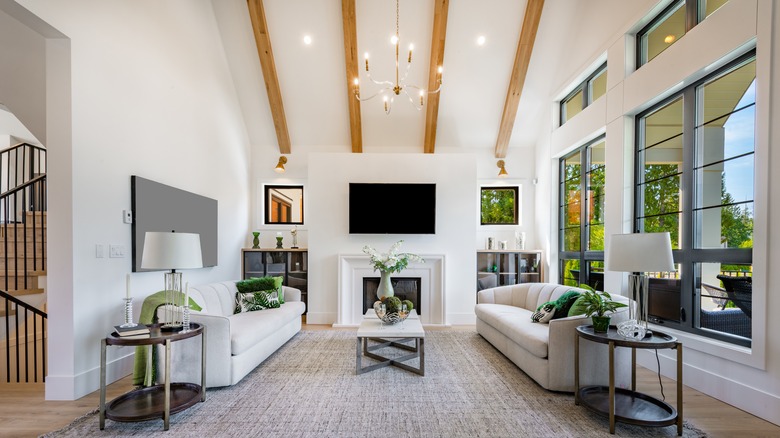The Most Popular Interior Decorating Styles
In some way, everyone has their own interior decorating style; however, it's sometimes hard to name what that style is. Or worse, you have blank walls and a house you don't enjoy because you don't know where to begin. Sometimes choosing a style is difficult when you like multiple types of decor or aren't aware of the many interior decorating options. According to CNN, Jill Waage of Better Homes and Gardens explains, "Thanks to nebulous decorator terms such as 'eclectic' or 'personalization,' interior decor isn't as easy to typify as it was even 10 years ago. That makes decorating harder than it used to be. Pick a decade. People are still looking for tips about how to use color, arrange furniture, always looking to make their home better."
Apparently, it's quite common to feel overwhelmed by the many interior decorating styles, and also common to want to embrace a specific style and create a home that showcases it. Follow along as we discuss 12 of the most popular decorating styles and demystify what each one means.
The uncomplicated minimalist
For those who prefer simplicity, minimalist décor brings peace to their lives. Though minimalism is truly a lifestyle, you can enjoy decorating with a minimalist style even if you don't necessarily live out the ideas of the practice. True minimalism is a way of living out a life that allows you more freedom, such as freedom from guilt, freedom from worry, and freedom from the consumer culture in which we live, according to The Minimalists. When applying this thought process to interior design, you're left with a home that is beautifully simple, clean, and free of clutter. It's not without style. It's a style that's created with the use of as little as possible. If that sounds freeing to you, then you may enjoy a minimalist home.
To achieve the style, Extra Space Storage recommends using neutral colors on the walls, such as white, cream, or light gray. Neutrals look clean, go well with everything, and cater to the simplicity of the minimalist style. Since lack of clutter is the goal with minimalism, make sure you declutter regularly, keeping only things that are needed and making sure everything has a place. With clean, neutral walls and decluttered spaces, you've got the perfect canvas for some minimalist furniture. Consider function as you choose furniture. Multipurpose furniture makes it easier to have less "stuff" in a room. For example, an ottoman that doubles as a coffee table and storage or a bed with built-in drawers mean fewer pieces of furniture in the room.
Hip industrial style
Do you love the idea of a hip loft in the city? If so, the industrial style will suit you well. Also referred to as industrial chic, the style is influenced by repurposed factories from the Industrial Revolution, according to Masterclass. It has a splash of minimalism to it, focusing more on open spaces, texture, and repurposed materials. Imagine wooden beams, exposed piping, interior brick walls, and hanging vintage-style light bulbs with no shades, and you'll get an idea of the industrial-style home. Although you'll see this style quite often in the open lofts of a city, you can have an industrial home right in the burbs or wherever you live.
Focus on the floors and walls first since that's what gives every home a backdrop. Go for wood floors, or if you want to be adventurous, pour a concrete floor for a hip industrial vibe. After the floors are complete, look to the walls and ceilings and add some texture wherever you can. You can do this by exposing or putting in a brick wall or adding wood beams to the ceiling.
The blank slate of an industrial-style home sounds like it could feel cold. However, when it's all put together and things like furniture are added, you're left with a warm and cozy space. To make an industrial home livable and warm, you need personal touches to soften the factory atmosphere. Andrea Michaelson of Andrea Michaelson Design points out in ELLE Decor, "When using an industrial space that has industrial finishes as a background, you need to add more homey items to give it some soul and counterpoint." Once walls, floors, and furniture are put into place, add your personal touches, such as family photos and artwork that you enjoy, to make the space comfortable and warm.
The modern home
The modern home is sleek and sophisticated with clutter-free counters and streamlined furniture designed with straight lines and soft, neutral colors, especially gray, white, and black. According to Extra Space Storage, a modern style home often has an open concept to create a better flow. Usually, it's the kitchen, living room, and dining area that all flow together.
The style takes a few ideas from other concepts, such as minimalism and industrial, using steel, concrete, and wood. Livingetc writes that modern interior design focuses on function, storage, geometric forms, and clear spaces. To create a modern vibe in your home, less is more, and function is everything. Little things like ditching the window treatments and leaving windows uncovered so you can have as much natural light as possible or switching from excess furniture in the living room to a few useful pieces and an ottoman that serves as storage and a coffee table are both quick ways to get you on the path to modern interior style. Whatever you choose, keep furniture and décor to a minimum and put function before form.
A traditional home
Traditional – the word conjures up feelings of nostalgia and going home to visit on the weekends. That's probably because many of us grew up in traditional homes. As parents are raising children, traditional decor is often a natural fit for busy families. It's simply...traditional. Items like wingback chairs and a floral-patterned sofa and loveseat are often seen in a traditional living room, while white kitchens with crown molding around the top of the cabinets are common, as well as brass or oil-rubbed bronze finishes on hardware and light fixtures. The traditional style is comforting and lovely, but you won't see much out of the ordinary in its design.
One element of the traditional design is its ability to bring a lot of texture into a room by incorporating florals, throw blankets, overstuffed pillows, and crown molding. Multi-Trade Building Services suggests chair rails and bead board on the walls to use as a canvas for your traditional style home. When painted white, the combination is classic and traditional. Another way to add texture is with rugs. Oriental rugs suit a traditional style well, as do floral patterns. Since wood flooring is popular in traditional homes, rugs are needed for warmth, texture, and comfort.
The contemporary style of today
Contemporary style is sometimes confused with modern style. Although they are similar, there are differences. 1stDIBS writes that modern style focuses on clean lines, simplicity, and function, while contemporary design is about present-day style, such as whatever is trending. Because of this, contemporary style is fluid and always evolving.
Today, you'll find a mix of materials, such as wood or bamboo for flooring and counters, and metal or stainless steel for use on counters and tables. Natural elements are popular as well in contemporary design. Plants, whether hanging or sitting on a shelf, bring nature inside and soften up a contemporary room. Every style has its own type of lines when it comes to furniture and decor. Unlike a modern style with simple straight lines, current contemporary lines are curvy, and shapes are unique with many angles. You might find a light fixture in a geometric shape or a uniquely shaped chair.
When painting your contemporary style home, try neutral colors on the walls then add contrast with the trim or artwork, using black and white. The fun part of a contemporary style is its ability to change. If you get bored easily and like to redecorate, contemporary may work well for you since you can continually change things up and still have the same style.
The mid-century modern home
The term mid-century modern covers a lot of decades and styles. It technically spans the 20th century from the 1930s to the 1960s, with most designers hovering around the 40s to 60s, according to Curbed. There's no denying that the show Mad Men put mid-century modern on the map. The sets were intricately created to replicate the 1960s and the details were part of what drew fans to the show. Mid-century modern furniture includes straight lines and less formality than the years before. Eleanor Trepte tells The Spruce, "The need and desire for functional, simplistic furniture and decor in our homes was a rebellion against the ornate traditions from decades before, and a way for families to embrace a more modern, organic way of living." Thankfully, you can still create this "rebellious" design in today's home.
Start by painting your walls in shades of orange, yellow, green, or blue. Neutral colors work as well. It was an eclectic time so there are a lot of color choices, but for walls, stick with lighter shades. Furniture materials consisted of metal and wood, mostly dark wood with peg-style legs. Think practical with straight lines. Many stores today, such as IKEA, sell furniture and light fixtures that are influenced by mid-century design, making it easy to create the vibe at home. You can also do some flea market and antique hunting to find original pieces. Adding a bar cart or a credenza to your living room gives the area an instant mid-century modern facelift.
The balanced transitional home
Do you consider yourself a modern person but love the comfort of traditional style? If so, your decorating style may be transitional. The transitional design merges traditional with modern. It's the perfect balance between an uncluttered and sophisticated style and traditional comforts. For example, a transitional living room might have modern coffee and side tables with a traditional, overstuffed couch. The straight edges of modern style are softened with a mix of traditional pieces and colors.
There are plenty of options when decorating a transitional home. Neutral colors on the walls are a good bet so you can easily mix different types of furniture, light fixtures, and accessories. Masterclass explains that one of the advantages of using neutral colors on the walls is that you can use any decorating style with them. They create the perfect blank slate for your design, especially transitional. When creating the transitional vibe, choose furniture that you like from both styles, either traditional or modern. If you enjoy traditional furniture but love the geometrical shapes of modern light fixtures and lamps, then you can easily mix those two elements together. Or if you prefer stainless steel countertops in the kitchen for a modern atmosphere, you can soften up those edges with traditional style cherry wood or white cabinets and crown molding. The transitional style is a great way to have fun with a lot of choices.
Natural vibes with rustic style
Outdoor adventurers and those who dream of a log cabin can bring that energy into their home with rustic interior decorating. It's the perfect style when you want to incorporate nature into your home. Rustic style is all things natural, warm, cozy, and with plenty of texture. In an article by Sprint Funding, Martha McNamara explains, "Rustic emphasizes simplicity and comfort in all elements. A fireplace, comfy furniture, soft throws, and a tasteful antler piece will go a long way in achieving that mountain style look." As you decorate to achieve this warm look, keep comfort and warmth in mind when painting the walls, adding flooring, and bringing in furniture and other décor. Imagine what elements you'd want in a cabin on a snowy day and that may help give you some ideas.
Furniture should be welcoming and never stiff looking. Overstuffed seats are perfect, along with ottomans to put your feet up. To make your comfy furniture even more welcoming, use plenty of throw blankets and pillows so everyone can easily curl up. Next, set the stage for your rustic style furniture, using wood flooring if you can. Wood is a common theme in rustic style and it's fine to get the look through hardwood, vinyl planks, or reclaimed wood.
In case you haven't noticed, texture is an important goal for rustic interior design, so when you see a space in your home that looks flat, consider what kind of texture you can add to it. It may be a rug, a blanket, wood beams, or maybe a basket filled with firewood.
Peace, love, and Bohemian style
Originating in the 1960s, the Bohemian style, also called boho, is all about natural elements and a casual, laid-back atmosphere. Designer Justina Blakeney explains, "It's a free-spirited aesthetic rooted in cultural mixing and an artistic sensibility," via House Beautiful. A Bohemian-style home feels lived in, in a good way. Once you've achieved your boho atmosphere, you'll feel surrounded by the things you love.
Natural elements are one of the best ways to get your boho theme going, and plants are the perfect option. Hanging plants with macrame hangers and placing plants in corners and on tables is an important part of the Bohemian style. Another element to incorporate in your décor is artwork. Paintings and prints with peaceful designs or bold colorful pieces can cover the walls.
Although plenty of white suits boho style well, you don't have to shy away from color. Earthy shades of green, blue, yellow, and red make a great backdrop for your Bohemian accessories and furniture. And speaking of furniture, keep it comfy. Formality has no place in a Bohemian-style home.
Coastal or Hamptons style
Can you hear the ocean? Then coastal style, also called Hamptons style, is calling your name. Comfort, light colors, and plenty of sunshine surround this beachy vibe. It's not about collecting seashells and putting them in jars on the mantel. There's much more to coastal style than that. Although the design is influenced by a beach atmosphere, it's evolved into something more sophisticated. Amy Leferink of Interior Impressions tells Forbes, "Over time this look has evolved to be less literal, and more an overall interpretation subject to the designer or homeowner and how they choose to bring the outside in, regardless of the home being situated in a coastal location. It is meant to evoke a feeling of being near the water— bringing the relaxation, ease, and casual vibe of waterside living to everyday life." That sounds lovely and you don't have to live on the beach to achieve it.
Your first step is to let the sunshine in. Coastal style is all about sunshine so if you can, remove window coverings. Another option for coastal-style windows is indoor plantation shutters that can open wide but also give privacy when needed. To go with your sunny atmosphere, lighten up the entire house with plenty of white, and pastel shades of blues, greens, yellows, and pinks. Use these soft colors on the walls, on cabinets, and in the colors you choose for the furniture. Coastal style feels breezy and light, so keep that in mind as you pick items for your home. Also, stay casual throughout your coastal design. The wonderful thing about coastal style is that it's sophisticated without feeling stuffy.
Warm French country style
French country style oozes coziness and warmth. There's no need to hold back from ornate furniture and décor when designing a French country home. One of the greatest benefits of this design is that you can add so many different elements to it. For example, you might have a simple farm-style table but surround it with scrolled, baroque-style seating. How fun is that? The more the merrier when it comes to French country. If you love rooms filled with flowers and lots of lovely things to look at and sit in, you may want to consider French country interior design for your home. Invaluable writes that French country décor encompasses distressed and lavish furnishings to create casual elegance. The key to French country is to blend the old with the new.
To create this wonderfully cozy aesthetic in your home, start with a soft, neutral palette on the walls, then bring in patterns, such as florals and toile in your furniture coverings, throws, and pillows. If you love to hunt for antique treasures, you've found the right style. Antique pieces amongst new items really pull together the French country home. Once you've got your furnishings in place, light up the room with opulent chandeliers and romantic table lamps. You don't have to hold back with French country, and that's what makes it so fun to design.
The modern farmhouse
Modern farmhouse style is like a rustic or country style, but somewhat softer and more contemporary. American Farmhouse Style writes that the modern farmhouse is simple, clean, and always welcoming. It's like a classic, rustic farmhouse meets modern décor.
This interior design uses a lot of white with pops of black, which is what gives sophistication to its otherwise casual style. Another common element is texture on walls and ceilings. If you've ever watched Chip and Joanna Gaines, you've learned what shiplap is. They made it famous and now you'll find it in modern farmhouse homes everywhere. Shiplap is basically wood paneling that is painted white, and it adds a wonderful character to walls.
Since the goal of the modern farmhouse is to be stylish and still welcoming, slipcovers in white, cream, or other light, neutral colors are great for furniture. They look stylish, keep the room casual, and are easy to take off and clean when needed.
In conclusion, there are many styles to choose from when decorating your home. It's best not to force one but go with the style that flows naturally with your personality.
